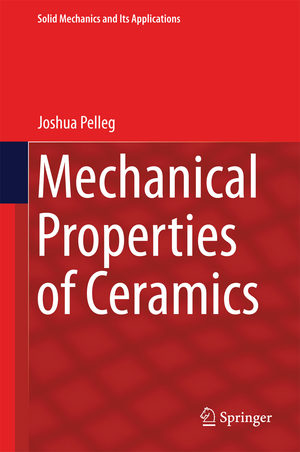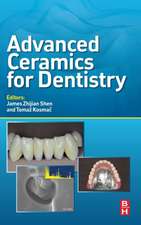Mechanical Properties of Ceramics: Solid Mechanics and Its Applications, cartea 213
Autor Joshua Pellegen Limba Engleză Hardback – 8 mai 2014
Generally, ceramics are made by moistening a mixture of clays, casting it into desired shapes and then firing it to a high temperature, a process known as 'vitrification'. The relatively late development of metallurgy was contingent on the availability of ceramics and the know-how to mold them into the appropriate forms. Because of the characteristics of ceramics, they offer great advantages over metals in specific applications in which hardness, wear resistance and chemical stability at high temperatures are essential. Clearly, modern ceramics manufacturing has come a long way from the early clay-processing fabrication method, and the last two decades have seen the development of sophisticated techniques to produce a large variety of ceramic material.
The chapters of this volume are ordered to help students with their laboratory experiments and guide their observations in parallel with lectures based on the current text. Thus, the first chapter is devoted to mechanical testing. A chapter of ductile and superplastic ceramic is added to emphasize their role in modern ceramics (chapter 2). These are followed by the theoretical basis of the subject. Various aspects of the mechanical properties are discussed in the following chapters, among them, strengthening mechanisms, time dependent and cyclic deformation of ceramics. Many practical illustrations are provided representing various observations encountered in actual ceramic-structures of particularly technical significance. A comprehensive list of references at the end of each chapter is included in this textbook to provide a broad basis for further studying the subject. The work also contains a unique chapter on a topic not discussed in other textbooks on ceramics concerning nanosized ceramics.
This work will also be useful as a reference for materials scientists, not only to those who specialize in ceramics.
| Toate formatele și edițiile | Preț | Express |
|---|---|---|
| Paperback (1) | 744.50 lei 43-57 zile | |
| Springer International Publishing – 3 sep 2016 | 744.50 lei 43-57 zile | |
| Hardback (1) | 750.48 lei 43-57 zile | |
| Springer International Publishing – 8 mai 2014 | 750.48 lei 43-57 zile |
Din seria Solid Mechanics and Its Applications
- 20%
 Preț: 698.09 lei
Preț: 698.09 lei - 24%
 Preț: 800.14 lei
Preț: 800.14 lei -
 Preț: 402.14 lei
Preț: 402.14 lei - 15%
 Preț: 640.06 lei
Preț: 640.06 lei - 15%
 Preț: 653.14 lei
Preț: 653.14 lei - 18%
 Preț: 1124.92 lei
Preț: 1124.92 lei - 15%
 Preț: 643.84 lei
Preț: 643.84 lei - 18%
 Preț: 1119.38 lei
Preț: 1119.38 lei - 20%
 Preț: 573.17 lei
Preț: 573.17 lei - 18%
 Preț: 1607.92 lei
Preț: 1607.92 lei - 17%
 Preț: 393.72 lei
Preț: 393.72 lei - 17%
 Preț: 459.40 lei
Preț: 459.40 lei - 18%
 Preț: 959.98 lei
Preț: 959.98 lei - 18%
 Preț: 747.71 lei
Preț: 747.71 lei -
 Preț: 388.55 lei
Preț: 388.55 lei - 18%
 Preț: 787.15 lei
Preț: 787.15 lei -
 Preț: 406.25 lei
Preț: 406.25 lei - 15%
 Preț: 639.08 lei
Preț: 639.08 lei - 24%
 Preț: 784.82 lei
Preț: 784.82 lei - 15%
 Preț: 643.34 lei
Preț: 643.34 lei - 18%
 Preț: 958.07 lei
Preț: 958.07 lei - 18%
 Preț: 1228.15 lei
Preț: 1228.15 lei - 18%
 Preț: 734.27 lei
Preț: 734.27 lei - 18%
 Preț: 1233.06 lei
Preț: 1233.06 lei - 18%
 Preț: 1236.19 lei
Preț: 1236.19 lei - 18%
 Preț: 950.96 lei
Preț: 950.96 lei - 18%
 Preț: 906.48 lei
Preț: 906.48 lei - 18%
 Preț: 964.54 lei
Preț: 964.54 lei - 20%
 Preț: 995.75 lei
Preț: 995.75 lei - 18%
 Preț: 953.65 lei
Preț: 953.65 lei - 18%
 Preț: 1239.67 lei
Preț: 1239.67 lei - 18%
 Preț: 962.35 lei
Preț: 962.35 lei - 18%
 Preț: 964.54 lei
Preț: 964.54 lei - 18%
 Preț: 913.11 lei
Preț: 913.11 lei - 18%
 Preț: 1226.90 lei
Preț: 1226.90 lei
Preț: 750.48 lei
Preț vechi: 915.22 lei
-18% Nou
Puncte Express: 1126
Preț estimativ în valută:
143.60€ • 150.34$ • 118.82£
143.60€ • 150.34$ • 118.82£
Carte tipărită la comandă
Livrare economică 07-21 aprilie
Preluare comenzi: 021 569.72.76
Specificații
ISBN-13: 9783319044910
ISBN-10: 3319044915
Pagini: 765
Ilustrații: XXII, 765 p. 780 illus., 169 illus. in color.
Dimensiuni: 155 x 235 x 50 mm
Greutate: 1.26 kg
Ediția:2014
Editura: Springer International Publishing
Colecția Springer
Seria Solid Mechanics and Its Applications
Locul publicării:Cham, Switzerland
ISBN-10: 3319044915
Pagini: 765
Ilustrații: XXII, 765 p. 780 illus., 169 illus. in color.
Dimensiuni: 155 x 235 x 50 mm
Greutate: 1.26 kg
Ediția:2014
Editura: Springer International Publishing
Colecția Springer
Seria Solid Mechanics and Its Applications
Locul publicării:Cham, Switzerland
Public țintă
ResearchCuprins
1 Mechanical Testing of Ceramics.- 2 Ductile Ceramics.- 3 Imperfections (Defects) in Ceramics.- 4 Deformation in Ceramics.- 5 The Strength and Strengthening of Ceramics.- 6 Time-Dependent Deformation – Creep.- 7 Cyclic Stress – Fatigue.- 8 Fracture.- 9 Mechanical Properties of Nano-Grain-Size Ceramics.- Index.
Textul de pe ultima copertă
This book discusses the mechanical properties of ceramics and aims to provide both a solid background for undergraduate students, as well as serving as a text to bring practicing engineers up to date with the latest developments in this topic so they can use and apply these to their actual engineering work.
Generally, ceramics are made by moistening a mixture of clays, casting it into desired shapes and then firing it to a high temperature, a process known as 'vitrification'. The relatively late development of metallurgy was contingent on the availability of ceramics and the know-how to mold them into the appropriate forms. Because of the characteristics of ceramics, they offer great advantages over metals in specific applications in which hardness, wear resistance and chemical stability at high temperatures are essential. Clearly, modern ceramics manufacturing has come a long way from the early clay-processing fabrication method, and the last two decades have seen the development of sophisticated techniques to produce a large variety of ceramic material.
The chapters of this volume are ordered to help students with their laboratory experiments and guide their observations in parallel with lectures based on the current text. Thus, the first chapter is devoted to mechanical testing, followed by the theoretical basis of the subject. Various aspects of the mechanical properties are discussed in the following chapters, among them, strengthening mechanisms, time dependent and cyclic deformation of ceramics. Many practical illustrations are provided representing various observations encountered in actual ceramic-structures of particularly technical significance. A comprehensive list of references at the end of each chapter is included in this textbook to provide a broad basis for further studying the subject. The work also contains a unique chapter on a topic not discussed in other textbooks on ceramics concerning nanosized ceramics.
This work will also be useful as a reference for materials scientists, not only to those who specialize in ceramics.
Generally, ceramics are made by moistening a mixture of clays, casting it into desired shapes and then firing it to a high temperature, a process known as 'vitrification'. The relatively late development of metallurgy was contingent on the availability of ceramics and the know-how to mold them into the appropriate forms. Because of the characteristics of ceramics, they offer great advantages over metals in specific applications in which hardness, wear resistance and chemical stability at high temperatures are essential. Clearly, modern ceramics manufacturing has come a long way from the early clay-processing fabrication method, and the last two decades have seen the development of sophisticated techniques to produce a large variety of ceramic material.
The chapters of this volume are ordered to help students with their laboratory experiments and guide their observations in parallel with lectures based on the current text. Thus, the first chapter is devoted to mechanical testing, followed by the theoretical basis of the subject. Various aspects of the mechanical properties are discussed in the following chapters, among them, strengthening mechanisms, time dependent and cyclic deformation of ceramics. Many practical illustrations are provided representing various observations encountered in actual ceramic-structures of particularly technical significance. A comprehensive list of references at the end of each chapter is included in this textbook to provide a broad basis for further studying the subject. The work also contains a unique chapter on a topic not discussed in other textbooks on ceramics concerning nanosized ceramics.
This work will also be useful as a reference for materials scientists, not only to those who specialize in ceramics.
Caracteristici
Winner of the 2015 Most Promising New Textbook Award from the Text and Academic Authors Association (TAA) Presents a general review of the mechanical properties of ceramics and aims to provide an overall understanding of the subject Surveys the various behaviors characteristic of ceramics in response to applied forces Includes many examples Includes supplementary material: sn.pub/extras








